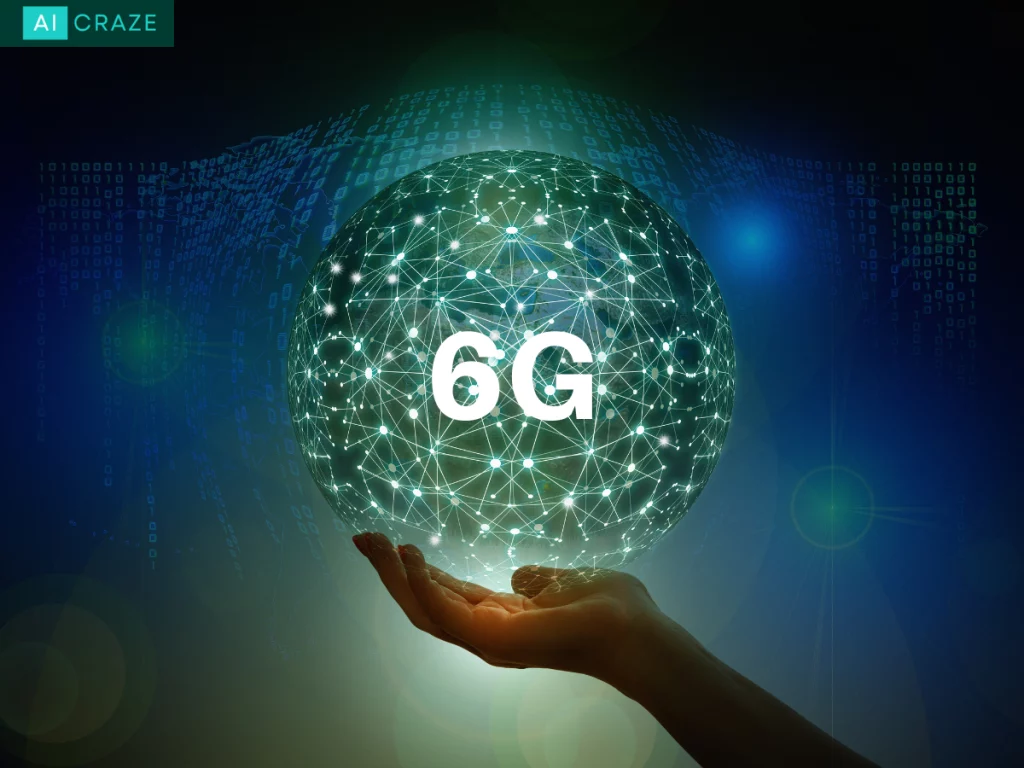
The development of wireless communication technology has revolutionized the world, and with each generation, it has brought significant improvements in speed, reliability, and accessibility. The fifth generation (5G) technology has been a game-changer in the telecommunication industry, and now researchers and experts are looking towards the sixth generation (6G) technology to take the world to the next level. In this article, we will explore the potential of 6G technology, its current status, advantages, dangers, and challenges.
What is 6G Technology?
The sixth generation of broad-region wireless technology is deemed as 6G technology. Every ten years, the International Telecommunication Union (ITU) standardizes wireless generations. The aim of 6G technology is to provide a considerably higher capacity and much lower latency compared to 5G technology.
One of the significant purposes of 6G technology is to uphold one-microsecond latency communications. It is equivalent to being 1,000 times faster, or 1/1000th the latency, of 5G networks. Furthermore, 6G networks will have the capability to employ higher frequencies than their precursor. We can expect that it will offer even greater capacity and faster speeds.
How Will 6G Be Faster Than 5G?
The new 6G technology is supposed to be faster than 5G, but we don’t know exactly how it will work yet. Some people think it might use really high radio waves called “millimeter waves” to go even faster. The way 5G works is that it uses high radio waves to carry lots of information. As you go higher up the radio spectrum, you can carry more and more information.
Comparison with Previous Generations of Mobile Connectivity
6G network technology is the successor to 5G, which is currently the most advanced form of mobile connectivity. Before 5G, 4G was the standard for mobile connectivity. 4G networks provided faster speeds, lower latency, and greater capacity than 3G networks, which were the previous standard.
With each new generation of mobile connectivity, there has been a significant improvement in terms of speed, capacity, and latency. This has allowed for faster downloads, smoother video streaming, and more reliable communication. 6G network technology is expected to be another step forward in mobile connectivity, with faster speeds and greater capacity than ever before.
Current Status of 6G Technology
It is still too early to predict what form 6G network technology will ultimately take. But it is clear that it will use ultrahigh frequencies (millimeter waves) of the radio spectrum to achieve faster data speeds than 5G. The development of 6G network technology is still in its early stages, and it is not yet standardized. However, it is expected to occur every 10 years or so, with 6G wireless technology being the sixth generation of wide-area wireless technology.
- Information about Recent Developments in 6G Technology
Samsung, a leader in wireless technology, held its first-ever 6G forum in Seoul in 2019. The company brought together experts from around the world to discuss the possibilities and challenges of 6G technology. Samsung believes that 6G network technology will be commercialized by 2028. It will support speeds up to 1,000 times faster than 5G.
VMware, a global leader in cloud infrastructure and digital workspace technology, has also unveiled its vision toward 6G technology. The company believes that 6G wireless technology will create a fully connected digital world. It will enable the Internet of Things (IoT) to reach its full potential. VMware predicts that 6G network technology will enable immersive experiences like augmented and virtual reality. It will be capable of supporting billions of connected devices.
- The Completion of the Study on the Early Development of 6G Wireless Technology by the US Department of Homeland Security
The US Department of Homeland Security (DHS) completed a study on the early development of 6G wireless technology in January 2020. The study explored the possibilities of 6G technology and its potential use cases. The study found that 6G technology will enable new applications and services, such as advanced augmented and virtual reality. It will enable new ways of remote learning and telemedicine. The DHS also identified challenges in developing 6G, such as a lack of available spectrum and the need for new infrastructure.
Potential Advantages of 6G Network Technology
The advancement of wireless communication technologies has been a driving force behind the digital revolution. The ongoing research and development around 6G network technology are poised to bring about groundbreaking improvements in connectivity. The potential advantages of 6G network technology are given below:
- Faster Data Transfer Rates and Lower Latency
One of the key benefits of 6G wireless technology is its ability to significantly improve download speeds and eliminate latency on mobile networks. With 6G network technology, data transfer rates are expected to reach unprecedented levels, allowing for lightning-fast downloads and seamless streaming experiences. Additionally, 6G technology aims to support one-microsecond latency communications, which is 1,000 times faster than the latency of 5G networks. This ultra-low latency will revolutionize applications that require real-time interaction, such as remote surgery, autonomous vehicles, and immersive virtual reality experiences.
- Increased Connectivity and Coverage
6G networks are anticipated to expand the boundaries of connectivity, providing improved coverage and access even in remote or previously underserved areas. This enhanced connectivity will enable seamless communication and data exchange across various devices and locations, fostering a more connected and integrated world. As a result, individuals, businesses, and industries will benefit from a broader network reach and improved accessibility to critical services and resources.
- Greater Reliability and Security
The development of 6G technology also includes a focus on enhancing reliability and security. 6G technology aims to deliver improved signal coverage through the implementation of advanced technologies, such as 3D Multiple-Input Multiple-Output (MIMO) systems. It optimizes signal reception and minimizes interference. Moreover, the role of 6G in security and privacy is being studied. It highlights the importance of robust measures to ensure data protection and confidentiality in wireless connectivity. This will be crucial in the era of increasing data exchange and reliance on interconnected devices.
- Improved Support for Emerging Technologies
With the emergence of technologies such as artificial intelligence (AI) and the Internet of Things (IoT), the demand for more advanced and capable wireless networks continues to grow. We can expect 6G technology to provide the infrastructure and support required for the seamless integration of these technologies into our daily lives. The combination of faster data transfer rates, lower latency, and increased capacity will enable the widespread deployment of AI-driven applications, smart city initiatives, and IoT devices. These lead to more efficient and intelligent systems.
6g Network Dangers
As the development of 6G networks progresses, it is crucial to understand and address the potential risks and dangers associated with this advanced technology. One of the significant concerns surrounding 6G networks is the vulnerability to cybersecurity risks. As with any connected system, there is a potential for cybersecurity attacks, such as hacking and malware injection. These attacks could compromise the privacy and security of users, leading to unauthorized access to sensitive information and potential disruptions in network services.
To mitigate these risks, robust cybersecurity measures must be implemented throughout the design and implementation of 6G networks. This includes employing advanced encryption algorithms, implementing robust authentication mechanisms, and regular security audits to detect and address potential vulnerabilities. Collaborative efforts between network operators, manufacturers, and cybersecurity experts are vital to ensuring the resilience and security of 6G networks.
Challenges for 6G Technology
The development and implementation of 6G technology bring forth a new set of challenges that need to be addressed. The challenges and considerations for 6G technology are given below:
- Regulatory and Policy Issues
As with any emerging technology, the regulatory and policy landscape plays a crucial role in shaping its deployment and usage. The implementation of 6G technology will require governments and regulatory bodies to establish frameworks. These will ensure fair competition, spectrum allocation, and privacy protection. Addressing these issues will foster an environment conducive to the widespread adoption and responsible use of 6G technology.
- Technological Challenges
The transition to 6G technology entails significant technological challenges that need to be overcome. One of the primary challenges is the need for substantial infrastructure upgrades. The deployment of 6G networks will require the installation of new base stations, antennas, and transmission equipment to support the higher frequencies and increased capacity. Additionally, the development of new hardware and software solutions, such as advanced chipsets and network protocols, is essential to enable the full potential of 6G technology.
- Environmental and Health Concerns
The potential benefits of 6G wireless technology are substantial, but we should address concerns regarding its potential negative impact on the environment and human health. The increased deployment of network infrastructure and the higher energy requirements of 6G networks may lead to an escalation in energy consumption and carbon footprint. It is crucial to mitigate these impacts through the development of energy-efficient technologies and sustainable practices. Furthermore, thorough research and adherence to established safety guidelines are necessary to address any potential health concerns associated with the implementation of 6G technology.
Conclusion
As wireless communication technology continues to advance, it is evident that 6G wireless technology holds great promise for the future. With faster data transfer rates, improved connectivity, and greater support for emerging technologies, 6G technology is poised to revolutionize the way we live and work. However, it is important to consider the challenges and potential risks associated with the implementation of this technology and to ensure that it is developed and deployed in a responsible and sustainable manner.
FAQs
How fast is 6g?
There is currently no clear answer to how fast 6G will be since the technology is still being researched and developed. However, it is expected that 6G will be much faster than its predecessor, 5G. Dr. Mahyar Shirvanimoghaddam from the University of Sydney has claimed that 6G wireless technology could deliver mind-boggling speeds up to 8,000 gigabits per second (Gbps). With this information, you can analyze how fast will 6G be.
What is the future scope of 6g technology?
The future scope of 6G technology is vast and promising, with potential advancements in areas. Such as virtual and augmented reality, autonomous vehicles, remote surgery, and smart cities. It is expected to have faster speeds, lower latency, higher capacity, and greater reliability than 5G. It will enable new and innovative applications. Researchers and engineers are exploring the use of new technologies such as terahertz waves, artificial intelligence, and advanced antenna systems to develop 6G technology.
When is 6g coming?
According to Ericsson’s CTO, Erik Ekudden, it is still too early to talk about the arrival of 6G. The development of the 6G is still in the early stages, and it is not yet standardized.
What are 6g speeds?
According to experts, 6G speeds are expected to be significantly faster than 5G. 6G networks will supposedly have 50-100x the capacity of 5G networks, and theoretical terabit speeds are expected to be delivered. Most users will get in excess of 100Gbps, but this is still subject to further research and development.
Is there 6g network available?
As of now, there is no commercial 6G network available since 6G is still in the research and development phase.
Is 6g dangerous?
There is currently no evidence to suggest that 6G is dangerous. While there is speculation about the potential capabilities of 6G, there is no mention of it being dangerous or harmful to humans or the environment. Therefore, it is safe to say that 6G is not dangerous at this time. But a few 6G network dangers that we can expect are discussed above.
Is there any specific date or guess about the 6g network release date or when is 6g coming out?
There is no exact 6G network release date but it is expected to be launched in 2030.

